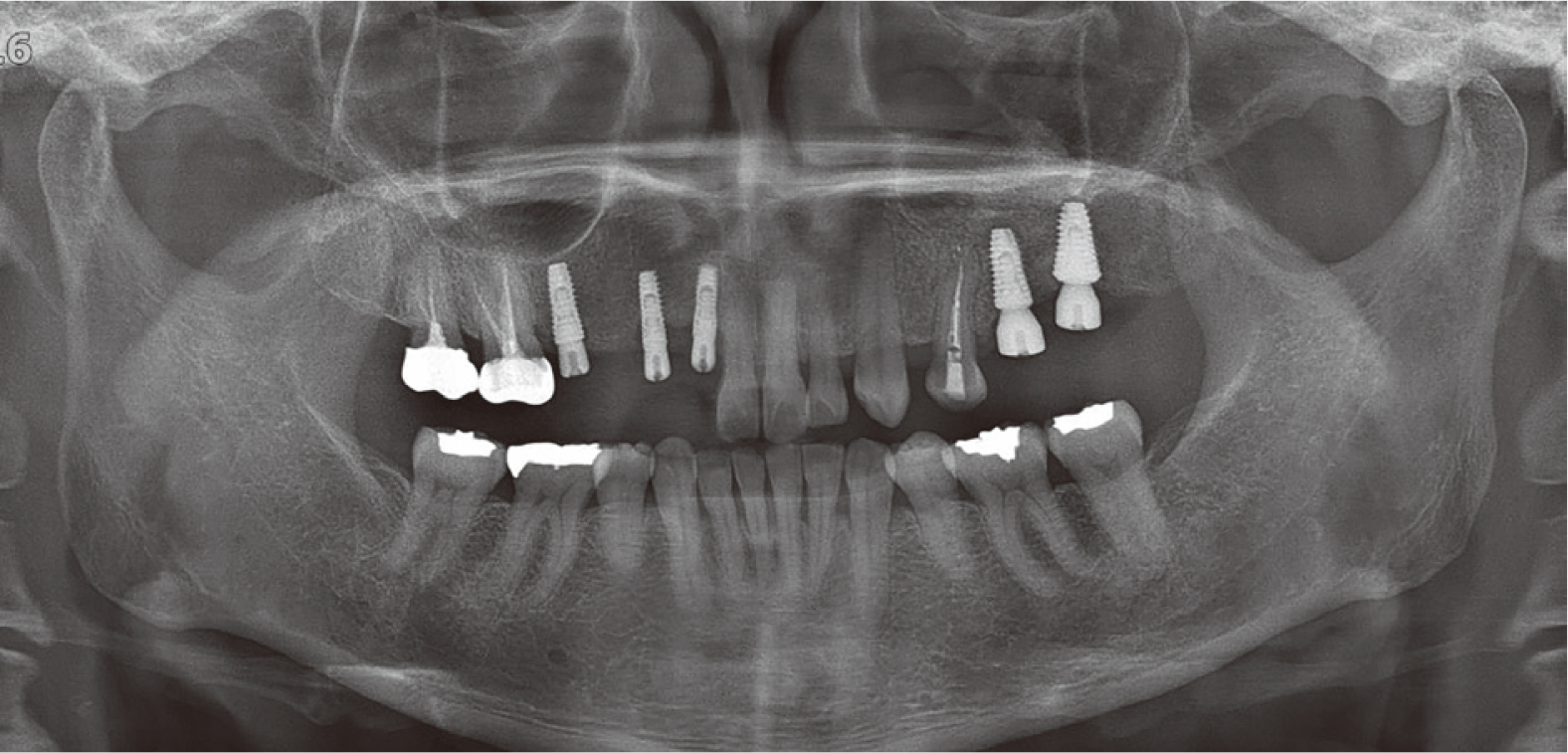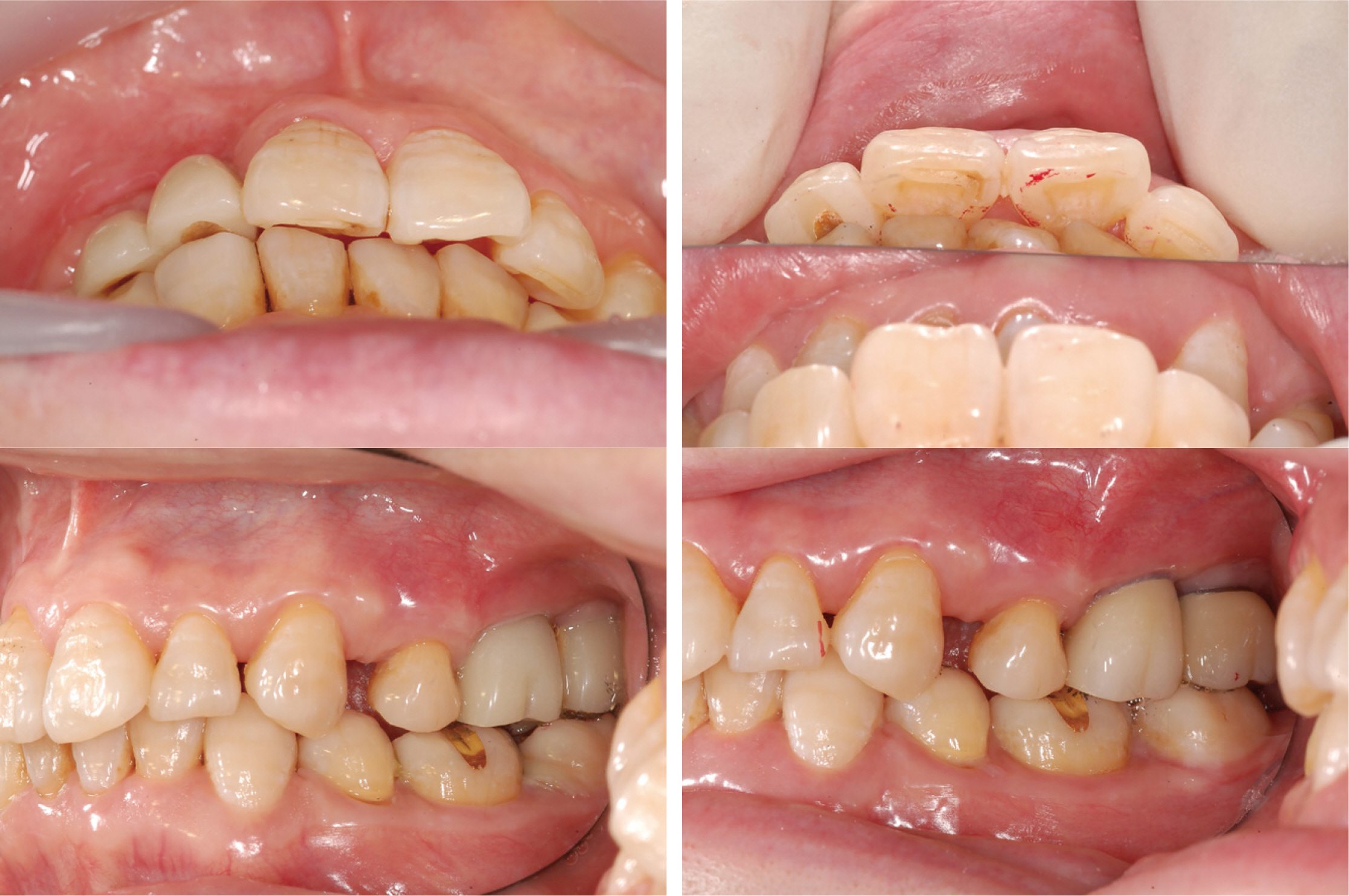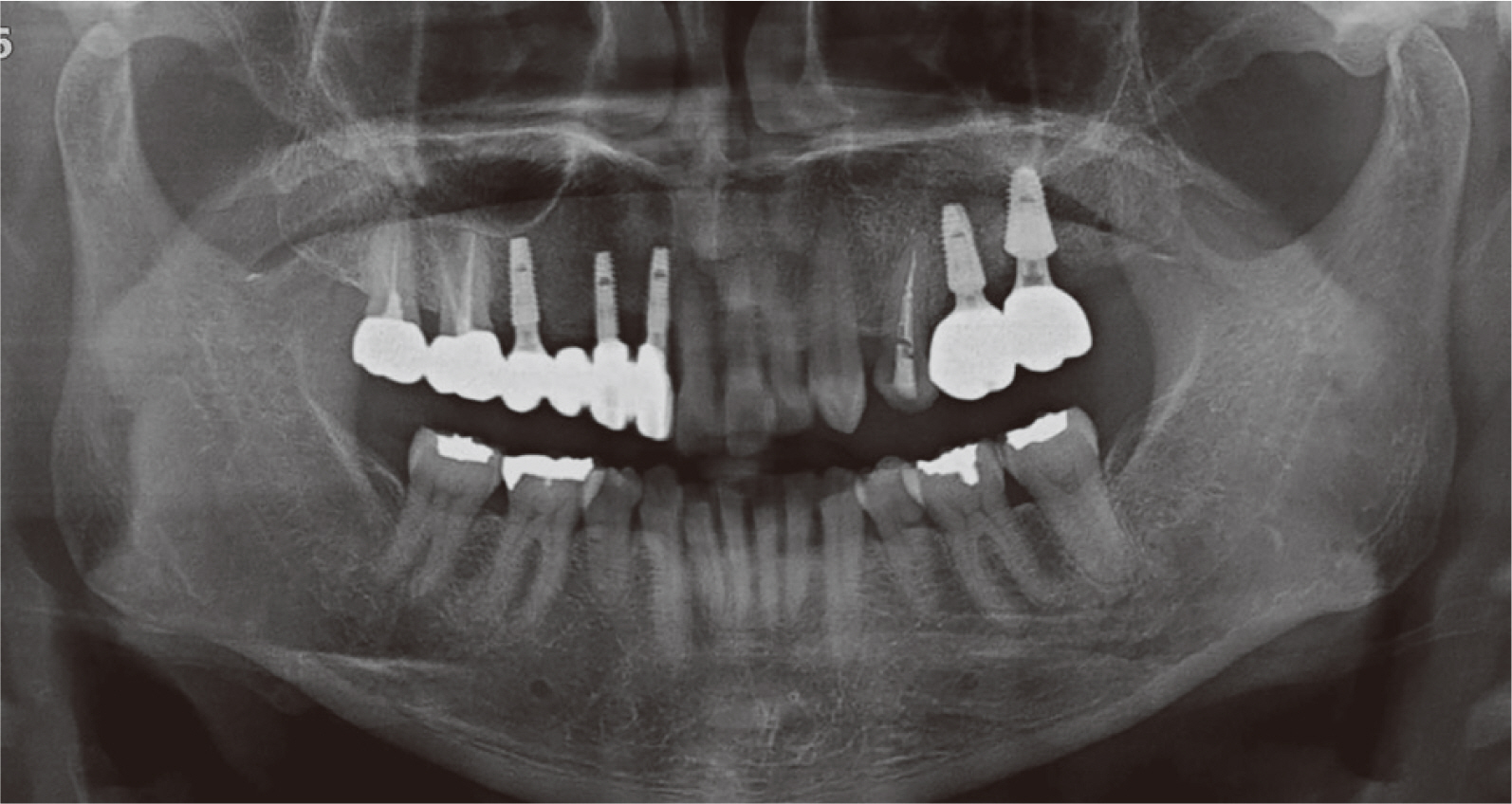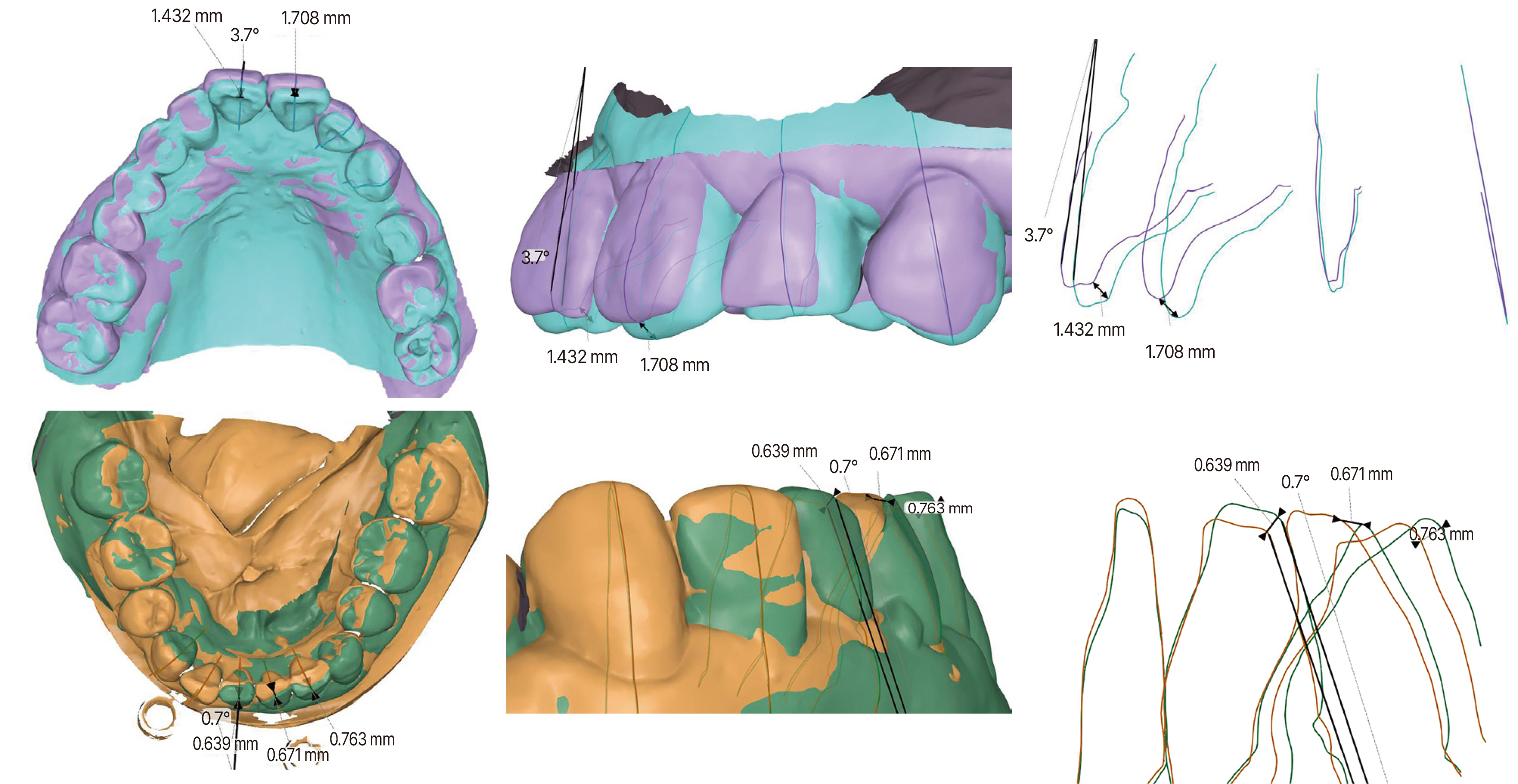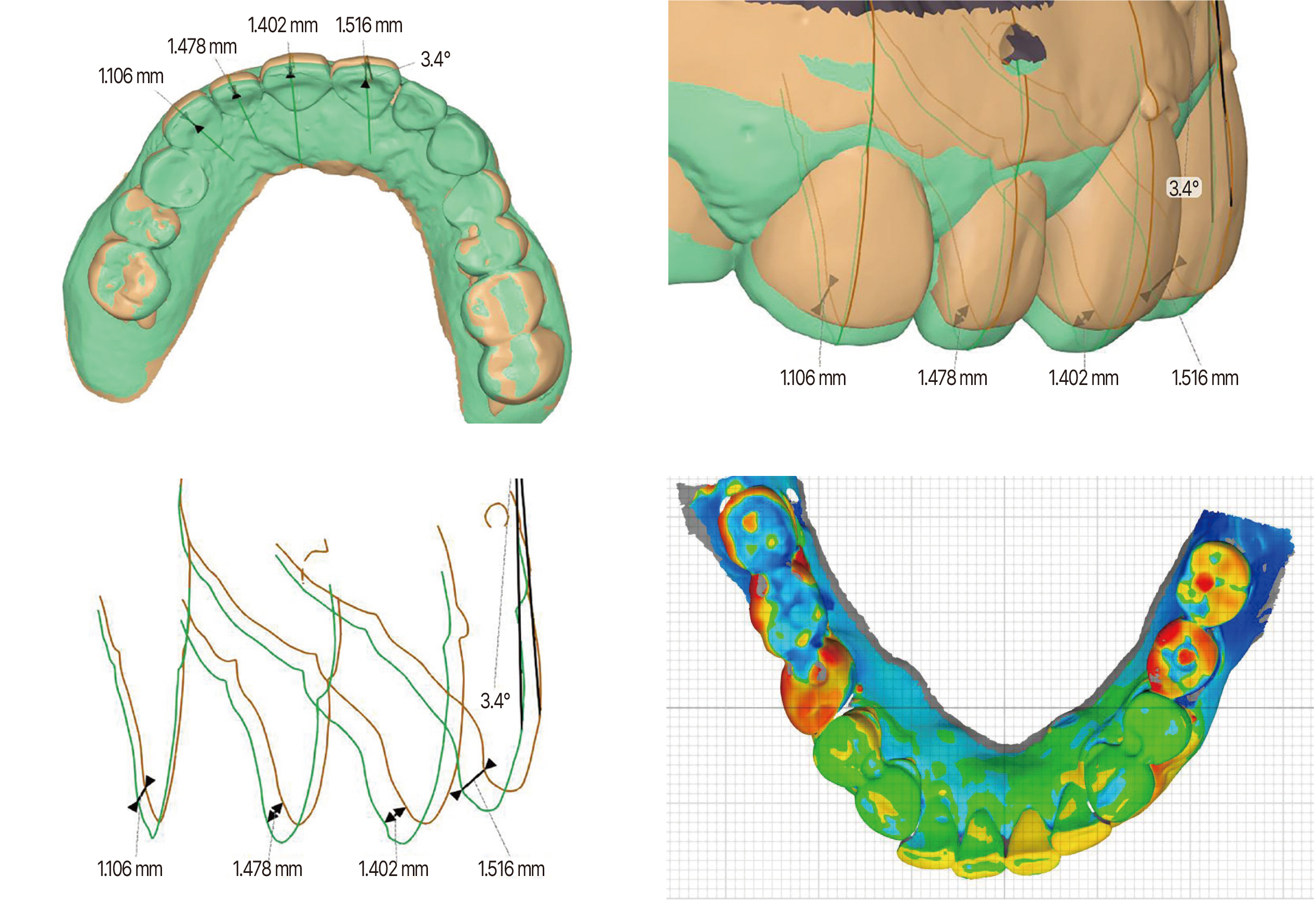J Dent Rehabil Appl Sci.
2023 Sep;39(3):146-157. 10.14368/jdras.2023.39.3.146.
New anterior guidance induction through spontaneous gap closure after an increase in vertical dimension: a case report
- Affiliations
-
- 1Department of Prosthodontics, Seoul National University Bundang Hospital, Seongnam, Republic of Korea
- 2Department of Dentistry, School of Dentistry, Seoul National University, Seoul, Republic of Korea
- KMID: 2549281
- DOI: http://doi.org/10.14368/jdras.2023.39.3.146
Abstract
- The bite collapses due to posterior teeth loss or wear results in inadequate space for restoration and esthetic concerns. Increasing the occlusal vertical dimension to improve space deficiency rotates the mandible posteriorly, creating a gap between the maxillary and mandibular anterior teeth, leading to loss of anterior guidance. To solve this problem, the prosthodontics or orthodontics treatments are the commonly used methods for proper anterior guidance. However, it is reasonable to assume that the anterior teeth can naturally relapse to their original position when the occlusal force is eliminated. Therefore, this case report aimed to test whether natural relapse could recover the lost anterior guidance to develop a less invasive and more convenient treatment method. Digital superimposition was used to evaluate the changes in anterior teeth alignment to confirm the change of the recovered anterior guidance. The appropriate indications for this new treatment method were defined and applied clinically.
Keyword
Figure
Reference
-
References
1. Poyser NJ, Porter RW, Briggs PF, Chana HS, Kelleher MG. 2005; The Dahl Concept: past, present and future. Br Dent J. 198:669–76. DOI: 10.1038/sj.bdj.4812371. PMID: 15951771.2. Nakamura SS, Donatelli D, Rosenberg ES. 2022; Posterior Bite Collapse: Guidelines for Treatment Based on Form and Function. Int J Periodontics Restorative Dent. 42:351–9. DOI: 10.11607/prd.5073. PMID: 35472111.3. Magne P, Magne M, Belser UC. 2007; Adhesive restorations, centric relation, and the Dahl principle: minimally invasive approaches to localized anterior tooth erosion. Eur J Esthet Dent. 2:260–73.4. Mizrahi B. 2006; The Dahl principle: creating space and improving the biomechanical prognosis of anterior crowns. Quintessence Int. 37:245–51.5. Rebibo M, Darmouni L, Jouvin J, Orthlieb JD. 2009; Vertical dimension of occlusion: the keys to decision: We may play with the VDO if we know some game's rules. Int J Stomatol Occ Med. 2:147–59. DOI: 10.1007/s12548-009-0027-7.6. Okeson JP. 2019. Management of temporomandibular disorders and occlusion - eBook. 8th ed. Elsevier Health Sciences;St. Louis:7. Amsterdam M. 1974; Periodontal Prosthesis. Twenty-five Years in Retrospect. Alpha Omegan. 67:8–52.8. Shifman A, Laufer BZ, Chweidan H. 1998; Posterior bite collapse - revisited. J Oral Rehabil. 25:376–85. DOI: 10.1046/j.1365-2842.1998.00243.x. PMID: 9639163.9. Ash MM, Ramfjord SP. 1995. Occlusion. 4th ed. W.B. Saunders;Philadelphia:10. Greenstein G, Cavallaro J, Scharf D, Tarnow D. 2008; Differential diagnosis and management of flared maxillary anterior teeth. J Am Dent Assoc. 139:715–23. DOI: 10.14219/jada.archive.2008.0253. PMID: 18519995.11. Johansson A, Johansson AK, Omar R, Carlsson GE. 2008; Rehabilitation of the worn dentition. J Oral Rehabil. 35:548–66. DOI: 10.1111/j.1365-2842.2008.01897.x. PMID: 18557919.12. Abduo J, Lyons K. 2012; Clinical considerations for increasing occlusal vertical dimension: a review. Aust Dent J. 57:2–10. DOI: 10.1111/j.1834-7819.2011.01640.x. PMID: 22369551.13. Hassall D. 2021; Centric relation and increasing the occlusal vertical dimension: concepts and clinical techniques - part one. Br Dent J. 230:17–22. DOI: 10.1038/s41415-020-2502-x. PMID: 33420450.14. Cardoso AC, Canabarro S, Myers SL. 2000; Dental erosion: diagnostic-based noninvasive treatment. Pract Periodontics Aesthet Dent. 12:223–8.15. Dahl BL, Krogstad O. 1983; The effect of a partial bite-raising splint on the inclination of upper and lower front teeth. Acta Odontol Scand. 41:311–4. DOI: 10.3109/00016358309162340. PMID: 6581670.16. Hoekstra-van Hout PMJ, Schols J, Mehta SB, Opdam NJM, Pereira Cenci T, Loomans BAC. 2023; Posterior Dahl: A Minimally Invasive Method for the Treatment of Localized Posterior Tooth Wear. J Adhes Dent. 25:31–8.
- Full Text Links
- Actions
-
Cited
- CITED
-
- Close
- Share
- Similar articles
-
- Full mouth rehabilitation of the patient with severely worn dentition: a case report
- Full mouth rehabilitation with vertical dimension increase in patient with loss of anterior guidance due to maxillary anterior teeth wear: A case report
- Functional and esthetic improvement through systematic diagnosis and treatment procedures in patient with unaesthetic anterior teeth proportion because of tooth wear: A case report
- A case of full mouth rehabilitation with orthodontic treatment in patient with extensive tooth erosion and wear using monolithic zirconia prostheses
- Evaluation methods of occlusal vertical dimension and their clinical applications: A narrative review

